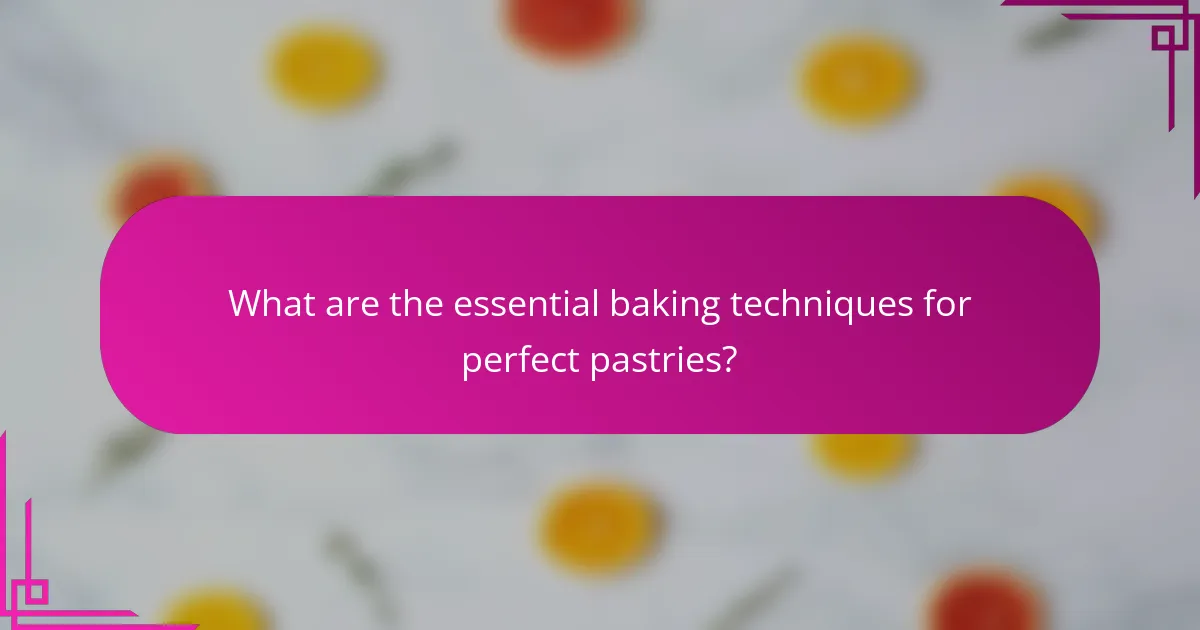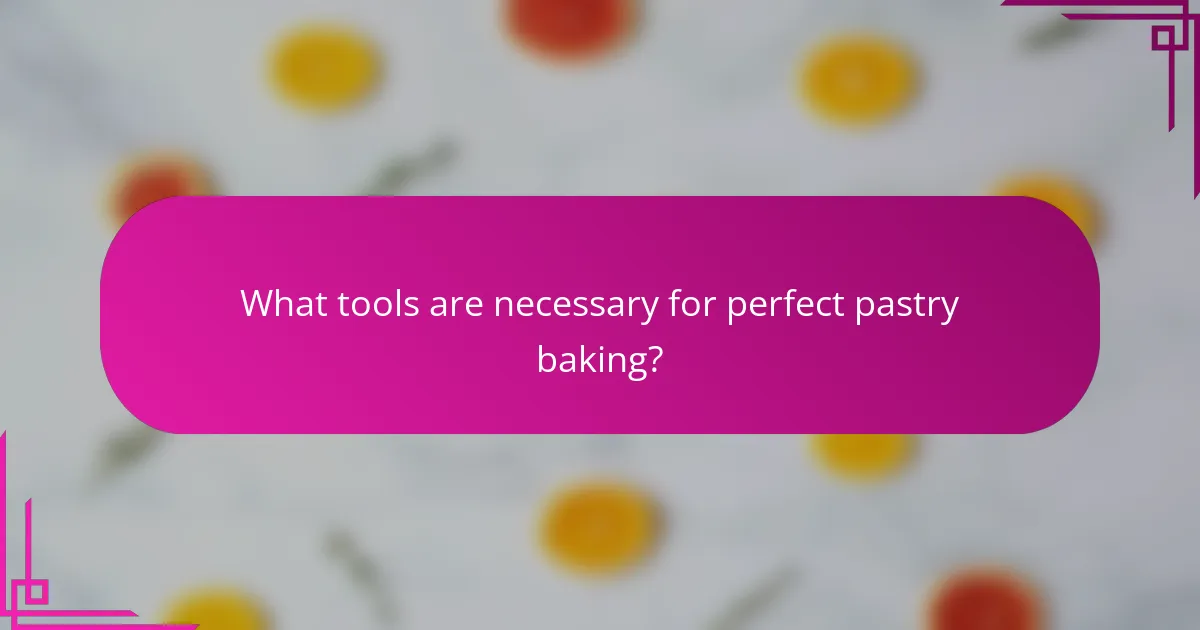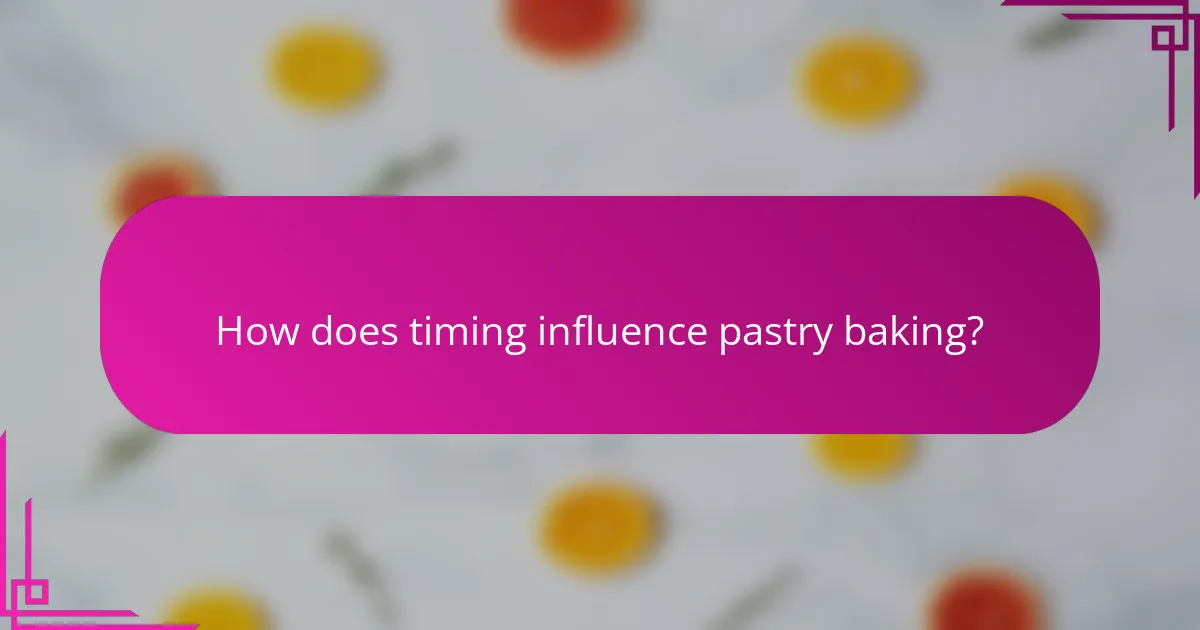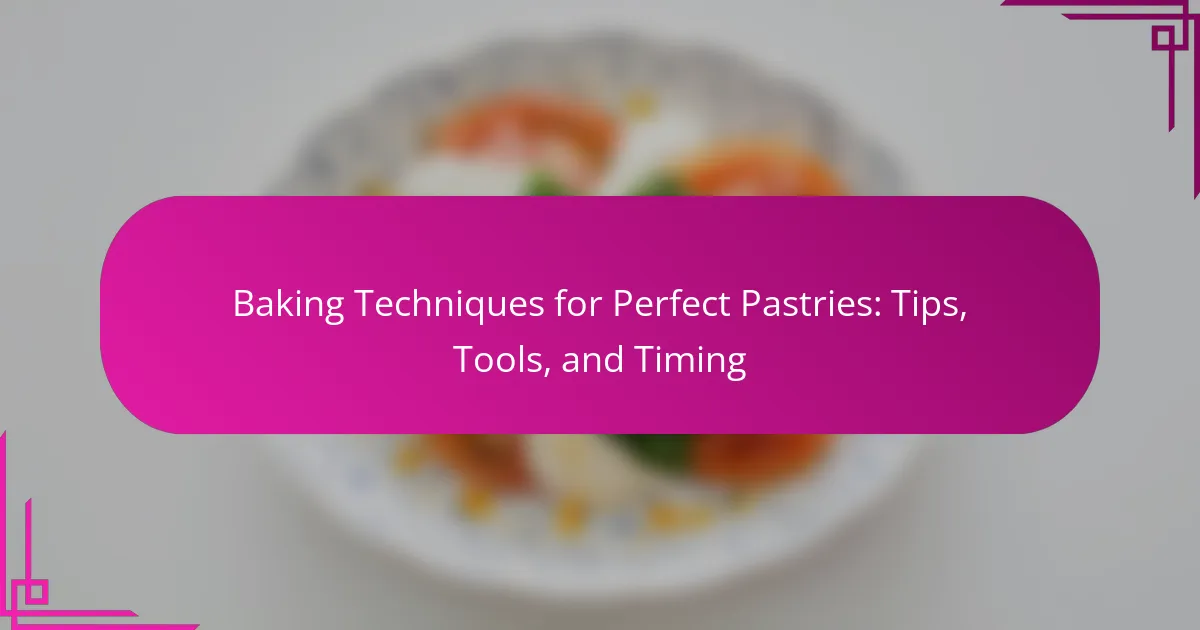Baking techniques for perfect pastries focus on essential practices such as proper mixing, temperature control, and precise baking times. Key methods include gentle mixing to avoid overworking dough, using cold ingredients for flakiness, and chilling dough for improved texture. Essential tools for pastry baking include a mixing bowl, pastry cutter, rolling pin, and baking sheets, which ensure even ingredient distribution and heat. Timing is critical, as it directly influences texture, flavor, and quality; accurate baking times are necessary to achieve optimal results for different pastry types. The article provides comprehensive insights into these techniques, tools, and timing considerations for successful pastry baking.

What are the essential baking techniques for perfect pastries?
Essential baking techniques for perfect pastries include proper mixing, temperature control, and precise baking times. Mixing should be done gently to avoid overworking the dough. Cold ingredients, especially butter, help create flaky layers. Chilling the dough before rolling ensures better texture. Accurate oven temperature is crucial for even baking. Using a thermometer can help maintain the right heat. Baking times vary by pastry type, requiring close monitoring. These techniques contribute to achieving the desired flakiness and taste in pastries.
How do different baking techniques impact pastry quality?
Different baking techniques significantly impact pastry quality. Techniques such as blind baking create a crisp crust by pre-baking the pastry shell. This method prevents sogginess in fillings. Steam baking introduces moisture, which can enhance flakiness in pastries like croissants. Using different temperatures alters texture; high heat can produce a puffier pastry. Additionally, techniques like folding and laminating layers contribute to a tender and flaky finish. Research shows that proper mixing methods affect gluten development, impacting the final structure. For instance, over-mixing can lead to tough pastries. Therefore, mastering various techniques is essential for achieving desired pastry characteristics.
What are the key techniques for creating flaky pastries?
Key techniques for creating flaky pastries include using cold ingredients, incorporating layers, and proper folding. Cold ingredients, such as butter and water, prevent the fat from melting too quickly. This helps maintain distinct layers during baking. Incorporating layers is essential; it involves rolling and folding the dough multiple times. Each fold creates more layers of fat and dough. Proper folding techniques, like the book fold or letter fold, enhance the flakiness. Additionally, resting the dough allows gluten to relax, which contributes to a tender texture. Finally, baking at a high temperature ensures that the layers puff up quickly, resulting in a flaky finish.
How does the method of mixing affect pastry texture?
The method of mixing significantly affects pastry texture. Different techniques create varying levels of gluten development. For instance, mixing by hand results in less gluten formation. This method yields a tender, flaky texture. Conversely, using a stand mixer or food processor promotes more gluten formation. This can lead to a denser, chewier pastry. Additionally, over-mixing can result in toughness. Therefore, the chosen mixing method directly influences the final texture of the pastry.
What role does temperature play in pastry baking?
Temperature is crucial in pastry baking as it affects texture, rise, and overall quality. The right temperature ensures proper fat melting, which creates flakiness. For example, cold butter in pastry dough results in a tender and flaky crust. Conversely, high temperatures can lead to over-browning or burning. Baking at the correct temperature allows for even cooking and proper expansion of leavening agents. This is evidenced by the fact that most pastry recipes specify temperatures between 350°F to 425°F. Maintaining consistent temperature during baking is essential for achieving desired results.
Why is preheating the oven important for pastry success?
Preheating the oven is crucial for pastry success because it ensures even cooking and proper rising. When the oven is preheated, the temperature is consistent from the start. This allows the pastry to begin cooking immediately, which is vital for achieving the desired texture. For example, flaky pastries require a hot environment to create steam quickly. This steam helps to separate the layers, resulting in a light and airy structure. Additionally, preheating prevents the pastry from becoming soggy. If placed in a cold oven, the pastry may not rise properly. Therefore, preheating is essential for optimal baking results.
How does ambient temperature affect dough preparation?
Ambient temperature significantly impacts dough preparation. Warmer temperatures accelerate yeast activity, leading to faster fermentation. This can result in over-proofing if not monitored. Conversely, cooler temperatures slow down yeast activity and fermentation. This can enhance flavor development but may require longer rising times. The ideal temperature for dough preparation typically ranges from 75°F to 80°F. At this range, yeast performs optimally, producing the desired texture and flavor. Studies show that dough left at room temperature for too long can lead to undesirable results, such as a dense texture. Thus, managing ambient temperature is crucial for successful dough preparation.

What tools are necessary for perfect pastry baking?
Essential tools for perfect pastry baking include a mixing bowl, pastry cutter, rolling pin, and baking sheets. A mixing bowl is necessary for combining ingredients evenly. A pastry cutter helps achieve the right texture by cutting butter into flour. A rolling pin is essential for rolling out dough to the desired thickness. Baking sheets are needed for even heat distribution during baking. Additionally, a whisk can be useful for mixing dry ingredients. A pastry brush is helpful for applying egg wash or butter. These tools collectively contribute to the precision and quality needed for successful pastry baking.
Which baking tools are essential for beginners?
Essential baking tools for beginners include measuring cups, mixing bowls, and a baking sheet. Measuring cups ensure accurate ingredient proportions. Mixing bowls allow for easy combining of ingredients. A baking sheet is necessary for cookies and pastries. Additionally, a whisk helps incorporate air into mixtures. A spatula is useful for folding and scraping. A rolling pin is essential for dough preparation. Finally, an oven thermometer ensures correct baking temperatures. These tools form the foundation for successful baking.
What are the must-have utensils for pastry preparation?
The must-have utensils for pastry preparation include a rolling pin, pastry cutter, mixing bowls, and measuring cups. A rolling pin is essential for flattening dough evenly. A pastry cutter helps to incorporate butter into flour for a flaky texture. Mixing bowls are necessary for combining ingredients effectively. Measuring cups ensure accurate ingredient quantities, which is crucial in baking. A whisk aids in mixing and aerating ingredients. A pastry brush is useful for applying egg wash or glaze. Lastly, a baking sheet provides a surface for baking pastries. These utensils are fundamental for achieving successful pastry results.
How do specialized baking tools enhance pastry results?
Specialized baking tools enhance pastry results by providing precision and consistency in preparation. Tools such as pastry cutters, rolling pins, and silicone mats ensure uniform thickness and even baking. Accurate measurements from tools like digital scales lead to better ingredient ratios. This precision reduces the risk of errors that can affect texture and flavor. For example, a pastry cutter allows for proper incorporation of fat into flour, resulting in a flakier pastry. Additionally, specialized molds and pans can influence the shape and presentation of pastries. Using non-stick baking tools minimizes sticking, ensuring clean removal and better appearance. Overall, these tools contribute to a more controlled baking environment, leading to improved pastry outcomes.
What are the benefits of using quality bakeware?
Quality bakeware enhances baking performance significantly. It ensures even heat distribution, resulting in uniformly baked goods. This reduces the chances of overcooking or undercooking. High-quality materials resist warping and scratching, providing durability over time. Non-stick coatings in quality bakeware facilitate easy release of baked items. This minimizes the need for excessive greasing, promoting healthier baking. Additionally, quality bakeware often withstands higher temperatures, making it versatile for various recipes. Investing in quality bakeware can lead to more consistent results and improved overall baking experience.
How does non-stick bakeware improve baking outcomes?
Non-stick bakeware improves baking outcomes by reducing the likelihood of food sticking to surfaces. This feature allows for easier release of baked goods, resulting in better presentation. Non-stick surfaces also promote even cooking by distributing heat uniformly. This uniformity helps prevent over-browning or undercooking. Additionally, non-stick bakeware often requires less oil or fat, making recipes healthier. Studies show that using non-stick materials can lead to a 30% reduction in the amount of grease needed. This characteristic can enhance the texture of baked items, making them lighter and fluffier. Overall, non-stick bakeware contributes to more successful and enjoyable baking experiences.
What materials are best for pastry pans?
The best materials for pastry pans are metal, glass, and silicone. Metal pans, especially aluminum and stainless steel, provide excellent heat conduction. This results in even baking and browning of pastries. Glass pans allow for easy monitoring of the baking process. They also retain heat well, promoting a consistent temperature. Silicone pans offer flexibility and easy release of baked goods. They are non-stick and require minimal greasing. Each material has unique benefits for different pastry types. For example, metal is preferred for pie crusts, while silicone is great for delicate pastries.

How does timing influence pastry baking?
Timing is crucial in pastry baking as it affects texture, flavor, and overall quality. For instance, overbaking can lead to dryness, while underbaking may result in a soggy texture. Each type of pastry has a specific baking time that ensures optimal results. For example, puff pastry requires precise timing to achieve the desired flakiness. Additionally, resting dough at the right intervals allows for proper gluten development. This development is essential for achieving the right structure in pastries. Accurate timing also impacts the final color and crispness of the crust. Ultimately, adhering to recommended baking times enhances the pastry’s characteristics, leading to a more enjoyable product.
What are the critical timing elements in baking pastries?
Critical timing elements in baking pastries include preparation time, resting time, baking time, and cooling time. Preparation time involves measuring and mixing ingredients, which typically takes 15 to 30 minutes. Resting time allows dough to relax, enhancing texture and flavor, usually requiring at least 30 minutes. Baking time varies by pastry type, often ranging from 15 to 45 minutes, depending on size and recipe specifics. Cooling time is essential for achieving the right texture and flavor development, generally lasting about 20 to 30 minutes after baking. Each timing element is crucial for achieving optimal results in pastry baking.
How does resting dough affect pastry development?
Resting dough significantly improves pastry development. It allows gluten to relax, leading to a more tender texture. During resting, the moisture in the dough is evenly distributed. This process helps prevent shrinkage during baking. Additionally, resting enhances flavor by allowing the ingredients to meld. Scientific studies indicate that resting for at least 30 minutes yields better results. For instance, a study by the American Institute of Baking found that resting dough improves overall pastry quality. Therefore, resting is a crucial step in pastry preparation.
What is the optimal baking time for various pastry types?
The optimal baking time for various pastry types varies significantly. For puff pastry, the baking time is typically 15 to 20 minutes at 400°F (200°C). Croissants generally require 15 to 25 minutes at the same temperature. Shortcrust pastry often bakes for 20 to 30 minutes at 350°F (175°C). Choux pastry usually needs about 25 to 30 minutes at 375°F (190°C). Danish pastry typically bakes for 20 to 25 minutes at 375°F (190°C). These times ensure proper cooking and texture. Adjustments may be needed based on oven performance and pastry thickness.
What are common timing mistakes to avoid in pastry baking?
Common timing mistakes in pastry baking include underbaking, overbaking, and misjudging resting times. Underbaking can lead to soggy or raw centers. Overbaking causes dryness and loss of texture. Misjudging resting times affects dough development. For instance, not allowing dough to rest can result in tough pastries. Conversely, resting too long can lead to overproofing. Additionally, not preheating the oven properly can impact baking times. Each of these timing errors can significantly alter the final product’s quality.
How can overbaking or underbaking impact pastry texture?
Overbaking or underbaking can significantly affect pastry texture. Overbaking leads to a dry and crumbly texture. It causes the moisture to evaporate, resulting in a tough pastry. The outer layer may become overly browned or burnt. Underbaking, on the other hand, results in a soggy or gummy texture. Insufficient heat prevents proper setting of the pastry structure. This can lead to an unappealing mouthfeel. Proper baking ensures a balanced texture that is flaky and tender.
What signs indicate that pastries are done baking?
Pastries are done baking when they are golden brown and firm to the touch. The color indicates that the sugars have caramelized properly. A toothpick inserted into the center should come out clean, showing that the inside is cooked. Additionally, the edges may pull away slightly from the pan. The aroma of baked goods will fill the kitchen. Finally, the pastries should have a slight sheen, indicating they are fully baked. These signs confirm that pastries have reached the desired doneness.
What practical tips can improve pastry baking skills?
To improve pastry baking skills, practice precise measurements and techniques. Use a kitchen scale for accurate ingredient portions. Maintain a consistent temperature for butter and eggs to ensure proper mixing. Chill dough before rolling to prevent shrinkage. Use parchment paper to prevent sticking and ensure even baking. Invest in quality tools like a pastry cutter and rolling pin for better results. Regularly check oven temperature with an oven thermometer for accuracy. Lastly, experiment with recipes to understand how different ingredients affect texture and flavor.
Baking techniques for perfect pastries encompass essential methods such as proper mixing, temperature control, and precise baking times. Key practices include using cold ingredients for flakiness, mastering various mixing techniques to influence texture, and understanding the critical role of oven temperature and preheating. The article also details the necessary tools for successful pastry baking, highlights the importance of timing in achieving optimal results, and offers practical tips to enhance baking skills. By exploring these aspects, readers will gain a comprehensive understanding of how to create high-quality pastries.
